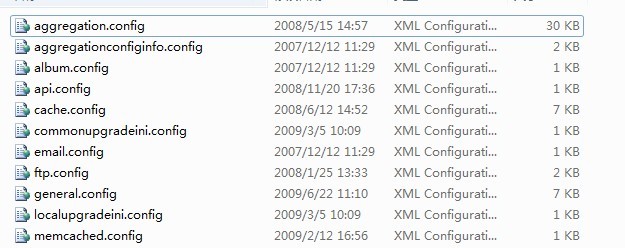建设一个对配置文件方便快捷操作的项目,是一个项目重要的建设模块之一,项目中很多方法都需要调用配置文件中的配置信息进行后续操作。以下是DNT发布包中的配置文件信息。

其实道理也很简单,就是将实体对象的状态序列化并且写入到配置文件中。需要用到的时候读取出配置文件反序列化成对象即可。但是也要考虑到一些因素,比如配置文件是否存在,配置文件最初的配置呈现,配置文件的保存路径,等等,这就需要我们自己对代码进行加工了。
config文件为XML格式文档,当然对其操作也少不了对其相关类的引用了。
using System.Xml;
using System.Xml.Serialization;
本项目内容不多,言简意赅,分为两部分,一是加载数据,二是保存(更新)数据。
加载数据:这里的加载数据,即将配置文件中的数据反序列化成对象,返回对象,方便开发人员对配置文件对象进行配置。为了方便公用,将其写作泛型方法。
1 /// <summary> 2 /// 获取配置信息 3 /// </summary> 4 /// <typeparam name="T">配置信息类</typeparam> 5 /// <returns></returns> 6 public static T GetConfig<T>() where T : class, new() 7 { 8 string configFilePath = GetConfigFilePath<T>(); 9 return (T)DeserializeInfo<T>(configFilePath, typeof(T)); 10 }
GetConfigFilePath方法 为获得配置文件路径,通常存放于根目录的Config文件夹中,也可对此方法进行修改,完成对配置文件存放目录的指定。
 获得文件所在路径
获得文件所在路径
1 /// <summary> 2 /// 获得文件所在路径 3 /// </summary> 4 /// <typeparam name="T">配置信息类</typeparam> 5 /// <returns></returns> 6 public static string GetConfigFilePath<T>() 7 { 8 string path = System.Web.HttpContext.Current.Server.MapPath("~/Config/"); 9 return path + typeof(T).Name + (".config"); 10 }
DeserializeInfo方法 是指定目录的配置文件进行反序列化成对象。
 将配置文件反序列化成对象
将配置文件反序列化成对象
1 #region 反序列化指定的类 + static IConfigInfo DeserializeInfo(string configFilePath, Type configType) 2 /// <summary> 3 /// 反序列化指定的类 4 /// </summary> 5 /// <param name="configFilePath">config文件的路径</param> 6 /// <param name="configType">指定的类型</param> 7 /// <returns></returns> 8 public static T DeserializeInfo<T>(string configFilePath, Type configType) where T : class,new() 9 { 10 string configChacheKey = "CK_SiteConfigCode_" + configType.Name; 11 T configinfo = SiteCache.Get<T>(configChacheKey); 12 13 if (configinfo == null) 14 { 15 if (IsGenner(configFilePath, (T)Activator.CreateInstance(configType)) == false) //判断是否有文件,没有则生成 16 { 17 using (XmlTextReader xmlTextReader = new XmlTextReader(configFilePath)) 18 { 19 XmlSerializer xmlSerializer = new XmlSerializer(configType); 20 configinfo = (T)xmlSerializer.Deserialize(xmlTextReader); 21 } 22 } 23 else 24 { 25 configinfo = new T(); 26 } 27 SiteCache.Get<T>(configChacheKey, () => configinfo, new CacheDependency(configFilePath)); 28 } 29 return configinfo; 30 } 31 #endregion
在DeserializeInfo方法中,有一段是用来判断是否存在配置文件的方法,如果存在,则直接反序列化成对象,然后返回给GetConfig方法中。如果不存在配置文件,则自动生成配置文件,即 IsGenner方法 。考虑到不断反序列化影响性能,将对象加入到缓存。
1 #region 是否存在配置文件(没有则生成) + static bool IsGenner<T>(string configFilePath, T configInfo) 2 /// <summary> 3 /// 判断是否存在配置文件(没有则生成) 4 /// </summary> 5 /// <param name="configFilePath">配置文件路径</param> 6 /// <param name="configInfo">临时配置变量</param> 7 /// <returns></returns> 8 public static bool IsGenner<T>(string configFilePath, T configInfo) 9 { 10 string directoryPath = System.Web.HttpContext.Current.Server.MapPath("/Config"); 11 12 if (!Directory.Exists(directoryPath)) 13 { 14 Directory.CreateDirectory(directoryPath); 15 } 16 17 FileInfo fileInfo = new FileInfo(configFilePath); 18 if (!System.IO.File.Exists(configFilePath) || fileInfo.Length == 0) 19 { 20 if (configInfo == null) 21 { 22 return false; 23 } 24 using (FileStream fs = new FileStream(configFilePath, FileMode.OpenOrCreate, FileAccess.Write, FileShare.ReadWrite)) 25 { 26 XmlSerializer xml = new XmlSerializer(configInfo.GetType()); 27 xml.Serialize(fs, configInfo); 28 } 29 return true; 30 } 31 return false; 32 } 33 #endregion
如果不存在配置文件,生成后,直接new 一个对象返回给GetConfig()方法。同时也跳过序列化数据这段代码,在这里,第一部分加载数据就这样了。
保存(更新)配置文件:传入一个实例对象,对实例对象进行序列化,并将内容进行写入到配置文件中,达到更新配置文件信息的效果。
1 #region 保存(序列化)指定路径下的配置文件 + public static bool SaveConfig<T>(string configFilePath, T configInfo) 2 /// <summary> 3 ///保存(序列化)指定目录下文件的配置信息 4 /// </summary> 5 /// <typeparam name="T">配置信息类</typeparam> 6 /// <param name="configFilePath">配置信息文件路径</param> 7 /// <param name="configInfo">配置信息</param> 8 /// <returns></returns> 9 public static void SaveConfig<T>(string configFilePath, T configInfo) 10 { 11 Type configType = typeof(T); 12 13 if (IsGenner(configFilePath, configInfo) == false) 14 { 15 try 16 { 17 XmlSerializer xmlSerializer = new XmlSerializer(configType); 18 using (XmlTextWriter xmlTextWriter = new XmlTextWriter(configFilePath, Encoding.UTF8)) 19 { 20 xmlTextWriter.Formatting = Formatting.Indented; 21 XmlSerializerNamespaces xmlNamespace = new XmlSerializerNamespaces(); 22 xmlNamespace.Add(string.Empty, string.Empty); 23 xmlSerializer.Serialize(xmlTextWriter, configInfo, xmlNamespace); 24 } 25 } 26 catch (SecurityException ex) 27 { 28 throw new SecurityException(ex.Message, ex.DenySetInstance, ex.PermitOnlySetInstance, ex.Method, ex.Demanded, (IPermission)ex.FirstPermissionThatFailed); 29 } 30 } 31 } 32 #endregion
所有的配置信息实体类,继承于这个配置信息操作基类即可。
